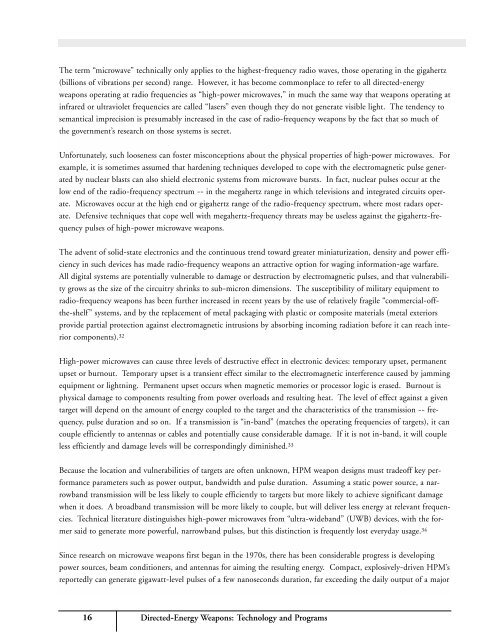directed-energy-weapons
directed-energy-weapons
directed-energy-weapons
You also want an ePaper? Increase the reach of your titles
YUMPU automatically turns print PDFs into web optimized ePapers that Google loves.
The term “microwave” technically only applies to the highest-frequency radio waves, those operating in the gigahertz(billions of vibrations per second) range. However, it has become commonplace to refer to all <strong>directed</strong>-<strong>energy</strong><strong>weapons</strong> operating at radio frequencies as “high-power microwaves,” in much the same way that <strong>weapons</strong> operating atinfrared or ultraviolet frequencies are called “lasers” even though they do not generate visible light. The tendency tosemantical imprecision is presumably increased in the case of radio-frequency <strong>weapons</strong> by the fact that so much ofthe government’s research on those systems is secret.Unfortunately, such looseness can foster misconceptions about the physical properties of high-power microwaves. Forexample, it is sometimes assumed that hardening techniques developed to cope with the electromagnetic pulse generatedby nuclear blasts can also shield electronic systems from microwave bursts. In fact, nuclear pulses occur at thelow end of the radio-frequency spectrum -- in the megahertz range in which televisions and integrated circuits operate.Microwaves occur at the high end or gigahertz range of the radio-frequency spectrum, where most radars operate.Defensive techniques that cope well with megahertz-frequency threats may be useless against the gigahertz-frequencypulses of high-power microwave <strong>weapons</strong>.The advent of solid-state electronics and the continuous trend toward greater miniaturization, density and power efficiencyin such devices has made radio-frequency <strong>weapons</strong> an attractive option for waging information-age warfare.All digital systems are potentially vulnerable to damage or destruction by electromagnetic pulses, and that vulnerabilitygrows as the size of the circuitry shrinks to sub-micron dimensions. The susceptibility of military equipment toradio-frequency <strong>weapons</strong> has been further increased in recent years by the use of relatively fragile “commercial-offthe-shelf”systems, and by the replacement of metal packaging with plastic or composite materials (metal exteriorsprovide partial protection against electromagnetic intrusions by absorbing incoming radiation before it can reach interiorcomponents). 32High-power microwaves can cause three levels of destructive effect in electronic devices: temporary upset, permanentupset or burnout. Temporary upset is a transient effect similar to the electromagnetic interference caused by jammingequipment or lightning. Permanent upset occurs when magnetic memories or processor logic is erased. Burnout isphysical damage to components resulting from power overloads and resulting heat. The level of effect against a giventarget will depend on the amount of <strong>energy</strong> coupled to the target and the characteristics of the transmission -- frequency,pulse duration and so on. If a transmission is “in-band” (matches the operating frequencies of targets), it cancouple efficiently to antennas or cables and potentially cause considerable damage. If it is not in-band, it will coupleless efficiently and damage levels will be correspondingly diminished. 33Because the location and vulnerabilities of targets are often unknown, HPM weapon designs must tradeoff key performanceparameters such as power output, bandwidth and pulse duration. Assuming a static power source, a narrowbandtransmission will be less likely to couple efficiently to targets but more likely to achieve significant damagewhen it does. A broadband transmission will be more likely to couple, but will deliver less <strong>energy</strong> at relevant frequencies.Technical literature distinguishes high-power microwaves from “ultra-wideband” (UWB) devices, with the formersaid to generate more powerful, narrowband pulses, but this distinction is frequently lost everyday usage. 34Since research on microwave <strong>weapons</strong> first began in the 1970s, there has been considerable progress is developingpower sources, beam conditioners, and antennas for aiming the resulting <strong>energy</strong>. Compact, explosively-driven HPM’sreportedly can generate gigawatt-level pulses of a few nanoseconds duration, far exceeding the daily output of a major16 Directed-Energy Weapons: Technology and Programs


